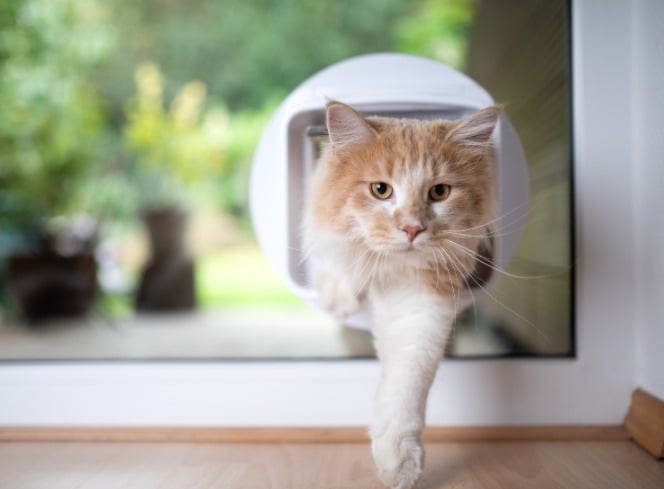When most people think of cats, they think of neighbourhood felines who can be seen climbing trees and stalking their territory. But not all felines are outdoor cats; if you have a pedigree cat it’s likely they live solely indoors with you. Even though their daily environment is different, they will have similar needs to their outdoor cousins that will need to be considered. If you're about to be the owner of a new indoor kitten there are some extra things to think about when preparing your home for their arrival. Read on to discover our Top Tips for Looking After Your Indoor Cat:
Kitten And Cat Essentials
The absolute essentials are pretty much the same for all cats, both indoor and outdoor. Here’s a handy shopping tick list for those preparing for the arrival of a new kitten:
When preparing for an indoor cat though, you’ll need to think about replicating some of the things an outdoor cat will do and experience inside.
Keep Your Indoor Cat Active
Indoor cats are naturally less active than their outdoor cousins simply due to the differences in environment. Those roaming outdoors will likely be chasing and climbing on a daily basis and have access to a wide area of land. It’s really important that you replicate this activity and provide your indoor cat with equipment that will encourage exercise. A good quality cat tree in a size as large as you have room for is a must. The more platforms and features it has the better, as you’ll want to encourage as much exercise as possible. Tall, floor-to-ceiling options are great for breeds such as Bengals who are naturally more active; they will love climbing their indoor territory. For those with limited space, wall mounted platforms and accessories are a great option, giving your feline the room to climb without taking up any floorspace.
Think about how many cats you have too; if you have a multi-cat household you will need to provide extra climbing space and activities. The more cats, the more climbing apparatus needed!
Encourage Scratching In The Right Places!
Scratching is natural and healthy for cats. It keeps their claws sharp and allows them to shed the dead husks from the nail. Whilst you definitely don’t want your felines scratching your precious furniture, you do need to provide them with somewhere to sate their scratching needs. A scratch post, pad or wall mount is a must. Your cat’s tree will almost definitely have scratch posts and pads built into it, but you could provide other scratching items around the house too. A cardboard scratcher is a great accessory. If you buy it in a large enough size, your cat will probably enjoy lounging on it when not scratching it! You could also try a hanging scratch pad which simply hang on door handles (but can be hooked on to anything stable)
Keep Your Indoor Cat Stimulated
It’s important to ensure your indoor cat doesn’t get bored. As well as a place to climb, provide them with toys and accessories to help keep their mind stimulated. Catnip toys are a great choice to encourage their hunting abilities and teaser wand toys will provide playtime with you - perfect bonding time. The important thing is to offer a range of toys and activities around the home that will encourage climbing, running, hunting and chasing. All these things will keep your cat active, exercised and healthy.
We love the Catit Senses 2.0 range of accessories in particular. Designed to appeal to every one of your cat’s unique senses, the toys and accessories can be used separately or put together to create the ultimate stimulating experience. The range includes activity tracks with chasing balls, scratch accessories, a cat grass garden and stimulating food games.
Choose A Good Quality, Specially Formulated Cat Food
Cats who live indoors are likely to have more hairballs than their outdoor cousins, put on weight more easily and have different energy requirements. Choose a dry cat food that has been specially formulated for Indoor Cats. These recipes have been formulated specifically for your indoor cats needs. You could speak to your breeder or Vet if you’re unsure which is best for your specific cat.
Give Them A Taste Of The Outdoors In A Safe Way
You could still allow your cat to experience the great outdoors without setting them free completely. If trained from kittenhood, cats can be taken out on a harness and lead and walked around the garden. If you think your cat will hate the idea, you could provide them with an outdoor cat enclosure, rather like a giant rabbit hutch. If you choose this idea, remember to provide all the things you would indoors (toys, scratching accessories and food etc) and make sure you check up on them often. If these options aren’t suitable for you, it may be that you leave a spot on a windowsill for your cat to perch safely and open a window slightly - your cat will be able to feel the fresh air and experience the sights and smells of the great outdoors from the safety of their home.
We hope our handy Indoor Cat Care Guide comes in useful. When preparing your cat’s indoor environment think about your home in particular and what will and won’t work for you. As long as all the needs of your cat are covered in some way, you’ll have happy, healthy cat in your care.
If you have any questions, do get in touch. We’d love to hear from you. Let us know what your cat does and doesn’t enjoy and send us your pictures - we always enjoy seeing your furry bundles of joy; canine, feline and other pets!


























































![[color:pepper]](http://www.lordsandlabradors.co.uk/cdn/shop/products/Champions-Only-Column-2.jpg?v=1673862954&width=533)
![[color:cappuccino]](http://www.lordsandlabradors.co.uk/cdn/shop/products/kings-_-queens-catharina-160-2.jpg?v=1673517478&width=533)
![[color:cappuccino]](http://www.lordsandlabradors.co.uk/cdn/shop/products/Kings-_-Queens-Ramses-158cm-Cat-Tree-3.jpg?v=1673525436&width=533)




































